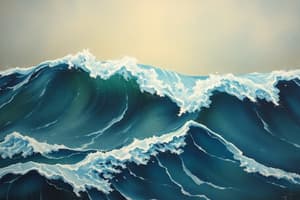Podcast
Questions and Answers
What type of wave has oscillations that are perpendicular to the direction of energy transfer?
What type of wave has oscillations that are perpendicular to the direction of energy transfer?
- Longitudinal waves
- Sound waves
- Transverse waves (correct)
- Mechanical waves
Longitudinal waves do not require a medium to travel.
Longitudinal waves do not require a medium to travel.
False (B)
Give an example of a transverse wave.
Give an example of a transverse wave.
Ripples
In sound waves, air particles create __________ and rarefactions.
In sound waves, air particles create __________ and rarefactions.
Match the wave types with their characteristics:
Match the wave types with their characteristics:
Flashcards
Transverse Waves
Transverse Waves
Waves that transfer energy by oscillating perpendicular to the direction of energy transfer. Think of ripples on water, where the water moves up and down, but the energy travels sideways.
Longitudinal Waves
Longitudinal Waves
Waves that transfer energy by oscillating parallel to the direction of energy transfer. Imagine compressing and stretching a spring. The spring particles move back and forth, but the energy travels along the spring.
Compressions
Compressions
Regions of a longitudinal wave where particles are close together, creating a high pressure.
Rarefactions
Rarefactions
Signup and view all the flashcards
Wave vs. Medium
Wave vs. Medium
Signup and view all the flashcards
Study Notes
Waves
- All waves are categorized into transverse and longitudinal waves.
- Waves transfer energy from one location to another.
- Ripples transfer kinetic energy; sound waves transfer sound energy.
Transverse Waves
- Oscillations are perpendicular to the direction of energy transfer.
- Ripples are an example of transverse waves: oscillations are up and down, while energy travels sideways.
- Not all transverse waves need a medium.
Longitudinal Waves
- Oscillations are parallel to the direction of energy transfer.
- Sound waves are an example, with air particles moving back and forth, creating compressions (tightly packed particles) and rarefactions (spread-out particles).
- All longitudinal waves require a medium (like air, liquid, or solid) to travel through.
Key Fact
- The wave travels, not the medium.
- This can be seen with a slinky: a single point (an air particle, or water molecule) oscillates but doesn't move through the medium.
Studying That Suits You
Use AI to generate personalized quizzes and flashcards to suit your learning preferences.



